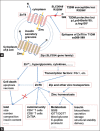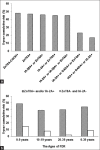Current and Future Clinical Applications of Zinc Transporter-8 in Type 1 Diabetes Mellitus
- PMID: 26315089
- PMCID: PMC4733793
- DOI: 10.4103/0366-6999.163389
Current and Future Clinical Applications of Zinc Transporter-8 in Type 1 Diabetes Mellitus
Abstract
Objective: To evaluate the utility of zinc transporter-8 (ZnT8) in the improvement of type 1 diabetes mellitus (T1DM) diagnosis and prediction, and to explore whether ZnT8 is a potential therapeutic target in T1DM.
Data sources: A search was conducted within the medical database PubMed for relevant articles published from 2001 to 2015. The search terms are as follows: "ZnT8," "type 1 diabetes," "latent autoimmune diabetes in adults," "type 2 diabetes," "islet autoantibodies," "zinc supplement," "T cells," "β cell," "immune therapy." We also searched the reference lists of selected articles.
Study selection: English-language original articles and critical reviews concerning ZnT8 and the clinical applications of islet autoantibodies in diabetes were reviewed.
Results: The basic function of ZnT8 is maintaining intracellular zinc homeostasis, which modulates the process of insulin biosynthesis, storage, and secretion. Autoantibodies against ZnT8 (ZnT8A) and ZnT8-specific T cells are the reliable biomarkers for the identification, stratification, and characterization of T1DM. Additionally, the results from the animal models and clinical trials have shown that ZnT8 is a diabetogenic antigen, suggesting the possibility of ZnT8-specific immunotherapy as an alternative for T1DM therapy.
Conclusions: ZnT8 is a novel islet autoantigen with a widely potential for clinical applications in T1DM. However, before the large-scale clinical applications, there are still many problems to be solved.
Figures


Similar articles
-
ZnT8 and type 1 diabetes.Endocr J. 2012;59(7):531-7. doi: 10.1507/endocrj.ej12-0069. Epub 2012 Mar 8. Endocr J. 2012. PMID: 22447136 Review.
-
Different role of zinc transporter 8 between type 1 diabetes mellitus and type 2 diabetes mellitus.J Diabetes Investig. 2016 Jul;7(4):459-65. doi: 10.1111/jdi.12441. Epub 2016 Jan 9. J Diabetes Investig. 2016. PMID: 27181765 Free PMC article. Review.
-
Characterization of zinc transporter 8 (ZnT8) antibodies in autoimmune diabetic patients from Argentinian population using monomeric, homodimeric, and heterodimeric ZnT8 antigen variants.Eur J Endocrinol. 2016 Feb;174(2):157-65. doi: 10.1530/EJE-15-0681. Epub 2015 Nov 13. Eur J Endocrinol. 2016. PMID: 26567119
-
Prediction and prevention of Type 1 diabetes mellitus.J Diabetes. 2011 Mar;3(1):48-57. doi: 10.1111/j.1753-0407.2010.00102.x. J Diabetes. 2011. PMID: 21073664 Review.
-
Triple chimeric islet autoantigen IA2-ZnT8WR to facilitate islet autoantibody determination.J Immunol Methods. 2010 Feb 28;353(1-2):20-3. doi: 10.1016/j.jim.2009.12.004. Epub 2009 Dec 24. J Immunol Methods. 2010. PMID: 20035758
Cited by
-
Gut microbiome in type 1 diabetes: A comprehensive review.Diabetes Metab Res Rev. 2018 Oct;34(7):e3043. doi: 10.1002/dmrr.3043. Epub 2018 Jul 17. Diabetes Metab Res Rev. 2018. PMID: 29929213 Free PMC article. Review.
-
Polymorphisms of the NLRC4 Gene are Associated with the Onset Age, Positive Rate of GADA and 2-h Postprandial C-Peptide in Patients with Type 1 Diabetes.Diabetes Metab Syndr Obes. 2020 Mar 19;13:811-818. doi: 10.2147/DMSO.S244882. eCollection 2020. Diabetes Metab Syndr Obes. 2020. PMID: 32256096 Free PMC article.
-
SLC30A8 Gene rs13266634 C/T Polymorphism in Children with Type 1 Diabetes in Tamil Nadu, India.J Clin Res Pediatr Endocrinol. 2019 Feb 20;11(1):55-60. doi: 10.4274/jcrpe.galenos.2018.2018.0195. Epub 2018 Sep 10. J Clin Res Pediatr Endocrinol. 2019. PMID: 30197307 Free PMC article.
-
Prokaryotic expression and characterization of the heterodimeric construction of ZnT8 and its application for autoantibodies detection in diabetes mellitus.Microb Cell Fact. 2017 Nov 13;16(1):196. doi: 10.1186/s12934-017-0816-4. Microb Cell Fact. 2017. PMID: 29132366 Free PMC article.
-
Vaccine for Diabetes-Where Do We Stand?Int J Mol Sci. 2022 Aug 22;23(16):9470. doi: 10.3390/ijms23169470. Int J Mol Sci. 2022. PMID: 36012735 Free PMC article. Review.
References
-
- 6th ed. Brussels, Belgium: International Diabetes Federation; 2013. International Diabetes Federation. IDF Diabetes Atlas. - PubMed
-
- Xu Y, Wang L, He J, Bi Y, Li M, Wang T, et al. Prevalence and control of diabetes in Chinese adults. JAMA. 2013;310:948–59. - PubMed
-
- Yang W, Lu J, Weng J, Jia W, Ji L, Xiao J, et al. Prevalence of diabetes among men and women in China. N Engl J Med. 2010;362:1090–101. - PubMed
Publication types
MeSH terms
Substances
LinkOut - more resources
Full Text Sources
Other Literature Sources
Medical

